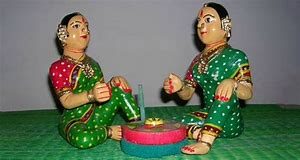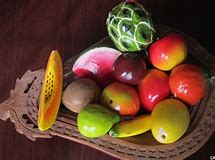Are you looking for Kinhal toys Karnataka then check out this post to know more. Karnataka has the immensely rich and artistic heritage.
One of the most flourishing crafts was wooden toys of Kinhal, Karnataka Kinhal, a small village of Raichur district in Karnataka. The well-known craft in this being flawless carvings on wood.
There were old paper tracings found in the ancestral home of one of the artist.
The paper gave substantial proofs that the mural paintings of Pampapateshwara temple and the elaborate work done on the wooden chariot of Hampi is done by the Kinhal artists.

Kinhal toys Karnataka
The traditional artisan Narayanappa Chitrakar told The Hindu that originally this art flourished in Vijayanagar.
The wooden statues of Shiva and Parvati at Virupaksha Temple and the intricate work on the wooden chariot at Hampi were said to be the work of the ancestors of Kinhal artisans of today.
History of Kinhal Toys
The artisans migrated to Kinnal village in Koppal district after the fall of the empire and the art identified itself with the village. Earlier, there were 50 families engaged in this art but today only two families were continuing the work, he said.
The Making of Kinhal Toys
Light wood of neem nugge (drumstick tree) and kitta (liquid and paste of tamarind seeds) are the basic materials used here. The artisans do multifarious job of cutting, polishing, painting and ornamenting the furniture.
Brushes made of hair of squirrel’s tail are used to do delicate painting. Small and big ornamental boxes, stools, low planks (chowkis), god-stands (peetha) and cradles are the specialization of these artisans. The subjects of the art could be mythological characters, birds, animals, creepers, flowers and fruit.

Today the artists of this craft not only make toys but also other objects made of wood. They then decorate these articles. The artists were titled as ‘Chitragars’ or makers of pictures. The wood used in this craft is from Polki, Hale and Hirelevu. These woods are light weighted.
The Dying Art of Kinhal Toys
These toys are made in various parts and these parts are glued together by a special paste, this paste is made of tamarind seeds and pebbles. Jute rags, soaked, slivered into pieces, dried, powdered, and mixed with saw dust and tamarind seed paste is made into kitta.
The ornamentation and jewelry on the body of the figure are pressed with the mixture of pebble powder paste with liquid gum. Once the various parts are organized together the artist smears kitta all over the craft with his hands. Then, small cotton pieces are stuck on the craft with tamarind paste on them. Next the pebble paste is applied again and this coat is the base for application of paint.
The craft piece are colored with the most vibrant colors of green, blue, yellow etc. Also the paint brush used in this craft is made out of squirrel’s tail. Earlier people preferred the toys of people from various occupation. But today they look out for toys of figures, animals and flowers.
Ganesha with his throne takes 22 components to get complete, and Garuda the epic bird takes 12 components. The style is real. The master touch of this toys is it’s designing and chiseling. In the festival season, the toys are made of sawdust and cow dung.

The Government’s Initiative to Revive Kinhal Toys
Presently, the changing trends in toy world the popularity and preference for Kinhal has been declining rapidly. The Government has taken initiatives for the revival of the traditional craftworks.
In the case of Kinhal toys the government is training families of the artisans. The government is trying to polish up the designs and textures of the toys. The government hopes to take the market for the toys all over India and abroad.


